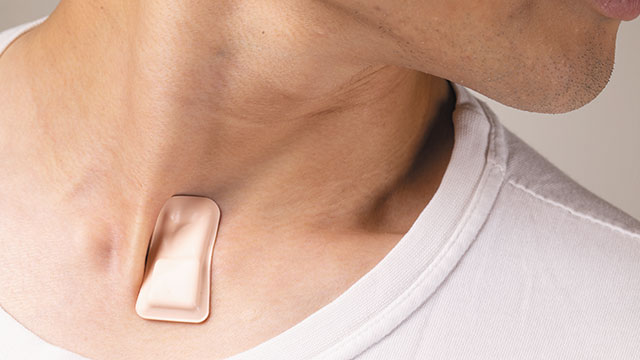
The more we learn about the novel coronavirus (COVID-19), the more unknowns seem to arise. These ever-emerging mysteries highlight the desperate need for more data to help researchers and physicians better understand — and treat — the extremely contagious and deadly disease.
Researchers at Northwestern University and Shirley Ryan AbilityLab in Chicago have developed a novel wearable device and are creating a set of data algorithms specifically tailored to catch early signs and symptoms associated with COVID-19 and to monitor patients as the illness progresses.
Capable of being worn 24/7, the device produces continuous streams of data and uses artificial intelligence to uncover subtle, but potentially life-saving, insights. Filling a vital data gap, it continuously measures and interprets coughing and respiratory activity in ways that are impossible with traditional monitoring systems.
Developed in an engineering laboratory at Northwestern and using custom algorithms being created by Shirley Ryan AbilityLab scientists, the devices are currently being used in a study at Shirley Ryan AbilityLab by COVID-19 patients and the healthcare workers who treat them. About 25 affected individuals began using the devices two weeks ago. They are being monitored both in the clinic and at home, totaling more than 1,500 cumulative hours and generating more than one terabyte of data.
About the size of a postage stamp, the soft, flexible, wireless, thin device sits just below the suprasternal notch — the visible dip at the base of the throat. From this location, the device monitors coughing intensity and patterns, chest wall movements (which indicate labored or irregular breathing), respiratory sounds, heart rate and body temperature, including fever. From there, it wirelessly transmits data to a HIPAA-protected cloud, where automated algorithms produce graphical summaries tailored to facilitate rapid, remote monitoring.
“The most recent studies published in the Journal of the American Medical Association suggest that the earliest signs of a COVID-19 infection are fever, coughing and difficulty in breathing. Our device sits at the perfect location on the body — the suprasternal notch — to measure respiratory rate, sounds and activity because that’s where airflow occurs near the surface of the skin,” said Northwestern’s John A. Rogers , who led the technology development. “We developed customized devices, data algorithms, user interfaces and cloud-based data systems in direct response to specific needs brought to us by frontline healthcare workers. We’re fully engaged in contributing our expertise in bioelectronic engineering to help address the pandemic, using technologies that we are able to deploy now, for immediate use on actual patients and other affected individuals. The measurement capabilities are unique to this device platform — they cannot be accomplished using traditional watch or ring-style wearables that mount on the wrist or the finger.”
“We anticipate that the advanced algorithms we are developing will extract COVID-like signs and symptoms from the raw data insights and symptoms even before individuals may perceive them,” said Arun Jayaraman , a research scientist at Shirley Ryan AbilityLab, who is leading the algorithm development. “These sensors have the potential to unlock information that will protect frontline medical workers and patients alike — informing interventions in a timely manner to reduce the risk of transmission and increase the likelihood of better outcomes.”
Continuous monitoring from hospital to home
The mysterious ways that COVID-19 affects the body seem to get stranger and stranger. Many patients’ symptoms fully disappear before they suddenly and unexpectedly begin deteriorating — sometimes within a matter of hours. Other patients have recovered and tested “negative” but later test “positive” again.
The unknowns underscore the need for continuous patient monitoring to ensure that physicians can intervene at the slightest sign of trouble. The Northwestern and Shirley Ryan AbilityLab teams’ device provides around-the-clock monitoring for COVID-19 patients and those exposed to them.
“Having the ability to monitor ourselves and our patients — and being alerted to changing conditions in real time — will give clinicians a new and important tool in the fight against COVID-19,” said Dr. Mark Huang, a physician at Shirley Ryan AbilityLab, who has worn the sensor. “The sensor also will offer clinicians and patients peace of mind as it monitors COVID-like symptoms, potentially prompting earlier intervention and treatment.”
The device can monitor hospitalized patients and then be taken home to continue 24/7 supervision. The real-time data streaming from patients gives insights into their health and outcomes that is currently not being captured or analyzed by traditional monitoring systems.
“Nobody has ever collected this type of data before,” Rogers said. “Earlier detection is always better and our devices provide important and unique capabilities in that context. For patients who have contracted the disease, the value is even more clear, as the data represent quantitative information on respiratory behavior, as a mechanism to track the progression and/or the effects of treatments.”
This story was originally published by Northwestern University.